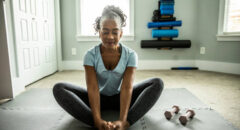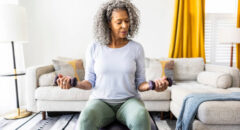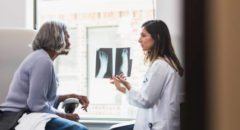
Millions of postmenopausal women find themselves facing a diagnosis of osteoporosis, but what does that mean for their daily lives?
About 30% of white postmenopausal women in the United States have osteoporosis, while 54% have osteopenia, a precursor to osteoporosis, according to Johns Hopkins Arthritis Center.
But what exactly is osteoporosis, and why is it such a concern? In this article, experts will explore osteoporosis, its causes, risk factors, symptoms, treatments and prevention strategies. We’ll also clarify the difference between osteopenia and osteoporosis, and explore exercises that can help strengthen your bones.
What is osteoporosis?
Osteoporosis, as defined by the U.S. National Institute of Arthritis and Musculoskeletal and Skin Diseases (NIAMS), is a condition where the density and mass of bones decrease, and the structure and strength of bones change. This weakening of bones can raise the risk of broken bones.
However, osteoporosis can also be defined by its silent nature. Typically, it develops without noticeable symptoms, and individuals may remain unaware of their condition until they experience a fracture. Osteoporosis is a primary cause of fractures in postmenopausal women and older men. It can affect any bones, but is most frequently seen in the hip, spine and wrist bones.
RELATED: Natural Remedies For Osteoporosis
Osteopenia vs. osteoporosis: What’s the difference?
According to the Cleveland Clinic, osteopenia refers to a reduction in bone mineral density (BMD) that results in the weakening of bones. This condition tends to be more prevalent in individuals aged 50 and above, particularly women. Unlike osteoporosis, osteopenia doesn’t exhibit any noticeable signs or symptoms, but a painless screening test can assess the strength of your bones.
Osteopenia is not as severe as osteoporosis, and not everyone will progress to osteoporosis. For individuals diagnosed with osteopenia, taking proactive steps to strengthen and protect their bones is essential, and healthcare providers should monitor their bone mineral density.
What causes osteoporosis?
Dr. Stephanie Kaye-Barrett, a London-based physician and rheumatologist, explained in a recent article that osteoporosis is primarily driven by the excessive activity of cells known as osteoclasts. These osteoclasts become hyperactive, leading to an excessive breakdown of bone tissue.
Furthermore, she noted that “the osteoblasts are the bone cells that build up new bone, and these are less active than they should be, and they don’t keep up with the breakdown which is caused by the osteoclasts.”
Osteoporosis risk factors
Numerous factors can influence your susceptibility to osteoporosis, such as your age, ethnic background, lifestyle choices and medical circumstances. However, some risk factors for osteoporosis are beyond your ability to change, according to the Mayo Clinic, and include:
- Gender: Women are more likely to develop osteoporosis than men
- Age: Your risk increases with advancing age
- Ethnicity: Individuals of white or Asian descent face the highest risk
- Family history: Your risk is higher if you have a parent or sibling who has osteoporosis, particularly if they suffered a hip fracture
- Body frame size: Those with smaller body frames, both men and women, tend to be at a higher risk, potentially due to having less bone mass available as they age
- Smoking: Cigarette smoking reduces bone density and impairs the body’s ability to absorb essential nutrients
RELATED: Osteoporosis and African American Women
Osteoporosis is a “silent” disease because it typically shows no symptoms until a bone is broken, per NIAMS. Symptoms linked to spinal fractures can include intense back pain, a noticeable loss of height or alterations in spinal alignment, leading to a stooped or hunched posture known as kyphosis.
Fractures can occur without warning due to:
- Insignificant tumbles, like a fall from a standing position, that wouldn’t typically result in a fracture in healthy bone
- Everyday pressures, such as bending, lifting or even coughing
The Cleveland Clinic lists the following additional symptoms of osteoporosis:
- Experiencing a reduction of one inch or more in your height
- Noticing alterations in your usual posture, which may involve stooping or an increased forward bend
- Encountering shortness of breath, potentially caused by the compression of spinal discs
- Dealing with lower back pain, specifically in the lumbar spine region
Osteoporosis treatment
If you have been diagnosed with osteoporosis, your physician will likely prescribe treatments to help manage pain and discomfort and slow disease progression. This may include a combination of medications, surgery and self-care.
Osteoporosis medications
Providers commonly prescribe various medications to treat osteoporosis, with some of the most frequent options being hormone therapies such as replacement estrogen or testosterone, and bisphosphonates.
For individuals facing severe osteoporosis or at a heightened risk of fractures, additional osteoporosis medications may be necessary. These monoclonal antibodies are typically administered through injections.
Osteoporosis self-care
You can incorporate these three essential osteoporosis self-care practices into your daily routine for maintaining strong and healthy bones:
- Stay active: Engage in strength and resistance training, balance exercises and low-impact aerobic activities like walking, dancing, tai chi, yoga and swimming
- Eat well: Consume a balanced diet rich in calcium and vitamin D to slow down bone loss and prevent osteoporosis-related fractures
- Get your vitamins: Ensure you have sufficient levels of vital nutrients, such as calcium and vitamin D, to support lifelong bone health
RELATED: Osteoporosis: 5 Unique Risk Factors In Black Women
Osteoporosis surgery
Spinal fractures, often linked to osteoporosis, may result in the need for surgery. Two common procedures are vertebroplasty and kyphoplasty, both minimally invasive.
- Vertebroplasty is a procedure to alleviate pain by injecting cement into spinal bones that have suffered cracks or fractures. It is most commonly employed to treat compression fractures. This minimally invasive technique offers relief by stabilizing weakened vertebrae.
- Kyphoplasty is a specialized procedure involving injecting a unique cement into the vertebrae, accompanied by a balloon-like device to create space for treatment. This approach not only has the potential to restore a damaged vertebra’s height but can also provide relief from associated pain.
Exercises for osteoporosis
Exercise can be very helpful in managing osteoporosis. Specific exercises bolster muscles and bones, while others enhance balance, reducing the risk of falls. Exercise can strengthen both muscles and bones and help prevent bone loss, NIAMS says.
Further, the Mayo Clinic says it’s never too late to start; regular physical activity can:
- Increase muscle strength
- Improve balance
- Decrease the risk of fractures
- Enhance posture
- Alleviate discomfort
Recommended activities for individuals with osteoporosis include upper back strength training, weight-bearing aerobic exercises like walking, flexibility routines, and stability and balance exercises.
Exercise choices may vary for those with advanced osteoporosis due to a higher fracture risk. Consult your primary care provider or physical therapist to determine the safest and most effective exercises for your needs.
How to prevent osteoporosis
Taking proactive steps to prevent weak bones is essential. Consider these strategies, as recommended by the National Institute on Aging:
- Nourish your bones: Consume calcium, vitamin D and protein-rich foods daily. Opt for low-fat dairy, leafy greens, fish and fortified beverages. Consult your doctor if you need vitamin D supplements.
- Stay active: Engage in weight-bearing exercises for osteoporosis, like strength training, walking, hiking, jogging, stair climbing, tennis and dancing to fortify your bones.
- Quit smoking: Smoking heightens the risk of bone weakening; seek support to quit if you smoke.
- Moderate alcohol: Excessive alcohol can harm bones; drink moderately or abstain to safeguard your bone health.
Living with osteoporosis
Consider these additional tips from Johns Hopkins Medicine to ensure a safe and fulfilling life:
- Stay active and connected: Engage in social activities and maintain physical activity to enhance overall well-being.
- Maintain balance: Regularly update eyeglass prescriptions to minimize the risk of falls.
- Open up: Share your thoughts and emotions with your doctor and loved ones to better manage the emotional aspects of living with osteoporosis.









